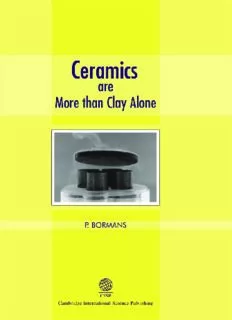
Ceramics Are More Than Clay Alone: Raw Materials, Products, Applications PDF
Preview Ceramics Are More Than Clay Alone: Raw Materials, Products, Applications
Introduction CERAMICS ARE MORE THAN CLAY ALONE Ceramics are more than clay alone Introduction (cid:1)(cid:2)(cid:3)(cid:4)(cid:5)(cid:6)(cid:1)(cid:7)(cid:8)(cid:4)(cid:3)(cid:2)(cid:8)(cid:5)(cid:9)(cid:3)(cid:2) (cid:10)(cid:11)(cid:4)(cid:12) (cid:1)(cid:13)(cid:4)(cid:14)(cid:8)(cid:4)(cid:13)(cid:9)(cid:12)(cid:2) (cid:1)(cid:2)(cid:3)(cid:4)(cid:5) (cid:6)(cid:7)(cid:8)(cid:9)(cid:2)(cid:10)(cid:11) CAMBRIDGE INTERNATIONAL SCIENCE PUBLISHING Ceramics are more than clay alone Published by Cambridge International Science Publishing 7 Meadow Walk, Great Abington, Cambridge CB1 6AZ, UK http://www.cisp-publishing.com First published 2004 © Paul Bormans © Cambridge International Science Publishing Conditions of sale All rights reserved. No part of this publication may be reproduced or trans- mitted in any form or by any means, electronic or mechanical, includ- ing photocopy, recording, or any information storage and retrieval sys- tem, without permission in writing from the publisher British Library Cataloguing in Publication Data A catalogue record for this book is available from the British Library ISBN 1 898326 7 70 Printed in the UK at the University Press, Cambridge Translated from the Dutch by Sis Achten Introduction About the Author (cid:1)(cid:2)(cid:3)(cid:4)(cid:5)(cid:12)(cid:13)(cid:14)(cid:13)(cid:5)(cid:6)(cid:7)(cid:8)(cid:9)(cid:2)(cid:10)(cid:11)(cid:1)(cid:2)(cid:3)(cid:4)(cid:1)(cid:5)(cid:6)(cid:7)(cid:8)(cid:1)(cid:9)(cid:8)(cid:1)(cid:10)(cid:11)(cid:12)(cid:13)(cid:1)(cid:9)(cid:8)(cid:1)(cid:14)(cid:15)(cid:8)(cid:16)(cid:15)(cid:17)(cid:6)(cid:18)(cid:1)(cid:19)(cid:15)(cid:20)(cid:21)(cid:15)(cid:7)(cid:17)(cid:3)(cid:8)(cid:22)(cid:4)(cid:23) (cid:24)(cid:25)(cid:20)(cid:15)(cid:7)(cid:1)(cid:21)(cid:9)(cid:4)(cid:1)(cid:15)(cid:22)(cid:26)(cid:27)(cid:3)(cid:20)(cid:9)(cid:6)(cid:8)(cid:1)(cid:9)(cid:8)(cid:1)(cid:27)(cid:21)(cid:15)(cid:28)(cid:9)(cid:4)(cid:20)(cid:7)(cid:29)(cid:1)(cid:3)(cid:20)(cid:1)(cid:20)(cid:21)(cid:15)(cid:1)(cid:30)(cid:8)(cid:9)(cid:31)(cid:15)(cid:7)(cid:4)(cid:9)(cid:20)(cid:29)(cid:1)(cid:6)(cid:25)(cid:1)(cid:19)(cid:9) (cid:28)(cid:15)(cid:16)(cid:15)(cid:8)(cid:18) (cid:19)(cid:15)(cid:20)(cid:21)(cid:15)(cid:7)(cid:17)(cid:3)(cid:8)(cid:22)(cid:4)(cid:18)(cid:1)(cid:21)(cid:15)(cid:1)(cid:5)(cid:15)(cid:27)(cid:3)(cid:28)(cid:15)(cid:1)(cid:3)(cid:1)(cid:20)(cid:15)(cid:3)(cid:27)(cid:21)(cid:15)(cid:7)(cid:1)(cid:3)(cid:20)(cid:1)(cid:3)(cid:1)(cid:4)(cid:27)(cid:21)(cid:6)(cid:6)(cid:17)(cid:1)(cid:25)(cid:6)(cid:7)(cid:1)(cid:17)(cid:3)(cid:5)(cid:6)(cid:7)(cid:3)(cid:20)(cid:6)(cid:7)(cid:29) !(cid:15)(cid:7)(cid:4)(cid:6)(cid:8)(cid:15)(cid:17)(cid:23)(cid:1)(cid:14)(cid:9)(cid:4)(cid:1)(cid:15)"(cid:20)(cid:15)(cid:8)(cid:4)(cid:9)(cid:31)(cid:15)(cid:1)(cid:9)(cid:8)(cid:20)(cid:15)(cid:7)(cid:15)(cid:4)(cid:20)(cid:1)(cid:9)(cid:8)(cid:1)(cid:8)(cid:3)(cid:20)(cid:26)(cid:7)(cid:3)(cid:17)(cid:1)(cid:4)(cid:27)(cid:9)(cid:15)(cid:8)(cid:27)(cid:15)(cid:4)(cid:1)(cid:7)(cid:15)(cid:4)(cid:26)(cid:17)(cid:20)(cid:15)(cid:22) (cid:9)(cid:8)(cid:1)(cid:3)(cid:1)(cid:8)(cid:26)(cid:28)(cid:5)(cid:15)(cid:7)(cid:1)(cid:6)(cid:25)(cid:1)(cid:5)(cid:6)(cid:6)#(cid:4)(cid:1)(cid:3)(cid:5)(cid:6)(cid:26)(cid:20)(cid:1)(cid:28)(cid:9)(cid:8)(cid:15)(cid:7)(cid:3)(cid:17)(cid:6)(cid:16)(cid:29)(cid:1)(cid:3)(cid:8)(cid:22)(cid:1)(cid:20)(cid:21)(cid:15)(cid:1)(cid:15)(cid:8)(cid:31)(cid:9)(cid:7)(cid:6)(cid:8)(cid:28)(cid:15)(cid:8)(cid:20)(cid:23) $(cid:8)(cid:1)(cid:20)(cid:21)(cid:15)(cid:1)(cid:29)(cid:15)(cid:3)(cid:7)(cid:4)(cid:1)(cid:10)(cid:11)%&’(cid:10)(cid:11)%(cid:13)(cid:1)(cid:21)(cid:15)(cid:1)(cid:2)(cid:6)(cid:7)#(cid:15)(cid:22)(cid:1)(cid:6)(cid:8)(cid:1)(cid:20)(cid:21)(cid:15)(cid:1)(cid:9)(cid:8)(cid:20)(cid:15)(cid:16)(cid:7)(cid:3)(cid:20)(cid:9)(cid:6)(cid:8)(cid:1)(cid:6)(cid:25)(cid:1)(cid:8)(cid:3)(cid:20)(cid:26)(cid:7)(cid:3)(cid:17) (cid:4)(cid:27)(cid:9)(cid:15)(cid:8)(cid:27)(cid:15)(cid:4)(cid:1)(cid:9)(cid:8)(cid:1)(cid:21)(cid:9)(cid:4)(cid:1)(cid:4)(cid:27)(cid:21)(cid:6)(cid:6)(cid:17)(cid:23)(cid:1)(cid:14)(cid:15)(cid:1)(cid:4)(cid:20)(cid:3)(cid:7)(cid:20)(cid:15)(cid:22)(cid:1)(cid:20)(cid:6)(cid:1)(cid:20)(cid:15)(cid:3)(cid:27)(cid:21)(cid:1)(cid:27)(cid:15)(cid:7)(cid:3)(cid:28)(cid:9)(cid:27)(cid:4)(cid:1)(cid:3)(cid:20)(cid:1)(cid:20)(cid:21)(cid:15) (cid:22)(cid:15)!(cid:3)(cid:7)(cid:20)(cid:28)(cid:15)(cid:8)(cid:20)(cid:1)(cid:28)(cid:3)(cid:20)(cid:15)(cid:7)(cid:9)(cid:3)(cid:17)(cid:1)(cid:20)(cid:15)(cid:27)(cid:21)(cid:8)(cid:6)(cid:17)(cid:6)(cid:16)(cid:29)(cid:1)(cid:6)(cid:25)(cid:1)(cid:21)(cid:9)(cid:4)(cid:1)(cid:4)(cid:27)(cid:21)(cid:6)(cid:6)(cid:17)(cid:23)(cid:1)((cid:21)(cid:15)(cid:1)(cid:5)(cid:3)(cid:4)(cid:9)(cid:4)(cid:1)(cid:6)(cid:25) (cid:21)(cid:9)(cid:4)(cid:1)(cid:20)(cid:15)(cid:3)(cid:27)(cid:21)(cid:9)(cid:8)(cid:16)(cid:1)(cid:28)(cid:3)(cid:20)(cid:15)(cid:7)(cid:9)(cid:3)(cid:17)(cid:4)(cid:1)(cid:9)(cid:4)(cid:1)(cid:20)(cid:21)(cid:15)(cid:1)(cid:4)(cid:27)(cid:6)!(cid:15)(cid:1)(cid:6)(cid:25)(cid:1)(cid:20)(cid:21)(cid:9)(cid:4)(cid:1)(cid:5)(cid:6)(cid:6)#(cid:23) ((cid:21)(cid:15)(cid:1))(cid:26)(cid:20)(cid:27)(cid:21)(cid:1)(cid:28)(cid:3)(cid:8)(cid:26)(cid:4)(cid:27)(cid:7)(cid:9)!(cid:20)(cid:1)(cid:2)(cid:3)(cid:4)(cid:1)(cid:20)(cid:7)(cid:3)(cid:8)(cid:4)(cid:17)(cid:3)(cid:20)(cid:15)(cid:22)(cid:1)(cid:9)(cid:8)(cid:1)*(cid:8)(cid:16)(cid:17)(cid:9)(cid:4)(cid:21)(cid:1)(cid:5)(cid:29)(cid:1)(cid:21)(cid:9)(cid:4) (cid:27)(cid:6)(cid:17)(cid:17)(cid:15)(cid:3)(cid:16)(cid:26)(cid:15)(cid:1)+(cid:23)(cid:1)(cid:24)(cid:27)(cid:21)(cid:20)(cid:15)(cid:8)(cid:23) Ceramics are more than clay alone Introduction (cid:1)(cid:8)(cid:15)(cid:16)(cid:2)(cid:17)(cid:15) In this preface I would like to reflect on the aspects which played a part in creating this book. In 1964 I embarked on my chemistry studies. Apparently the sub- jects ‘inorganic chemistry’ and ‘crystallography’ had most appeal for me during my education, because some years later I became inter- ested in geology and mineralogy as a hobby. The earlier mentioned specialities stood me in good stead here (or were they the cause of my interest ?) and my hobby developed into a large collection of silicate minerals. After graduating I started to teach at a laboratory school where I have been employed ever since. At the beginning of the eighties Dutch trade and industry were of the opinion that materials science ought to be introduced into laboratory education. Since ceramics are mainly based on inorganic compounds and silicates play a major role here, I gladly volunteered to teach this subject. I enthusiastically threw myself into ceramics and have since written a lot of instructional material from a multidisciplinary approach. This means that ceramics can only be studied successfully by students with an interest in natural sci- ences, varying from the geology of the formation of raw materials to the use of ceramics implants in man and animals, with an extensive range of applications and specialities in between. My spheres of interest and my disposition to teach natural sciences as a whole comprising of related subjects were my main inspirations for writing this book. An interest in ceramics and a readiness to gain more knowledge of other specialities are important prerequisites in order to successfully utilize it. Finally, I would like to take this opportunity to thank all the com- panies and people who contributed either in the form of literature, photographs or texts. Special thanks go to my colleague Sis Achten for translating my Dutch text into the English language. Paul Bormans Susteren, The Netherlands Ceramics are more than clay alone Contents Introduction...................................................................................................1 2 History and Future of Ceramics ................................ 4 2.1 INTRODUCTION............................................................................................4 2.2 THE BEGINNING...........................................................................................5 2.3 MATERIALS THROUGHOUT THE CENTURIES...................................8 2.4 A BRIEF HISTORY...................................................................................... 11 2.5 HISTORY OF TECHNICAL CERAMICS IN THE NETHERLANDS..21 2.6 TEACHING CERAMICS.............................................................................22 2.7 A VIEW TO THE FUTURE.........................................................................24 3 Chemistry................................................................... 25 3.1 INTRODUCTION..........................................................................................25 3.2 THE STRUCTURE OF AN ATOM.............................................................26 3.3 THE PERIODIC TABLE OF ELEMENTS................................................29 3.4 CHEMICAL BOND.......................................................................................30 3.4.1 Electronegativity............................................................................................30 3.4.2 Kinds of bonds................................................................................................31 3.5 PHYSICAL PROPERTIES OF SUBSTANCES.........................................36 3.6 ELEMENTS AND COMPOUNDS ..............................................................37 3.7 CHEMICAL CALCULATIONS IN PURE SUBSTANCES AND IN MIXTURES....................................................................................................40 3.7.1 The concept 'mole'..........................................................................................40 3.7.2 Density............................................................................................................42 3.7.3 Mass fraction,..................................................................................................... 3.7.4 Mass concentration........................................................................................44 3.7.5 Analytical concentration...............................................................................44 3.8 CHEMICAL EQUATIONS ..........................................................................45 3.9 ACIDS AND BASES.....................................................................................46 3.10 ELECTROLYTES.........................................................................................50 3.11 ORGANIC CHEMISTRY............................................................................52 3.11.1 Introduction...................................................................................................52 3.11.2 Organic compounds ......................................................................................53
Description: